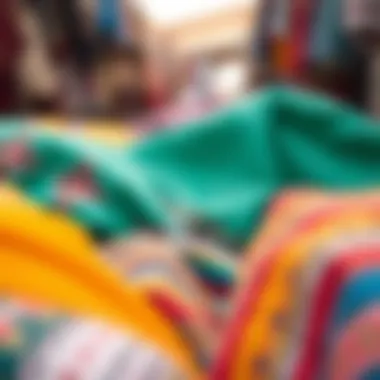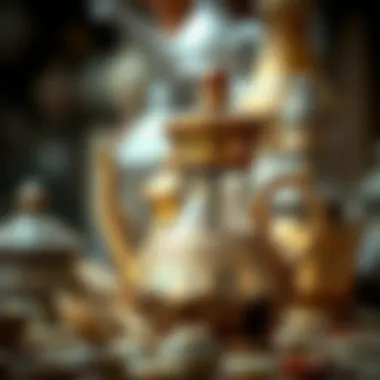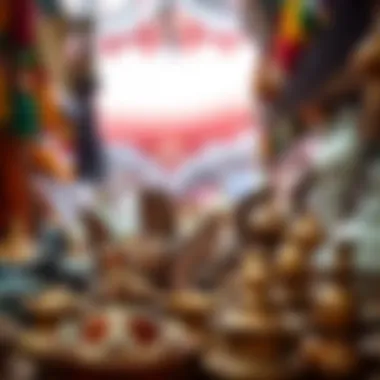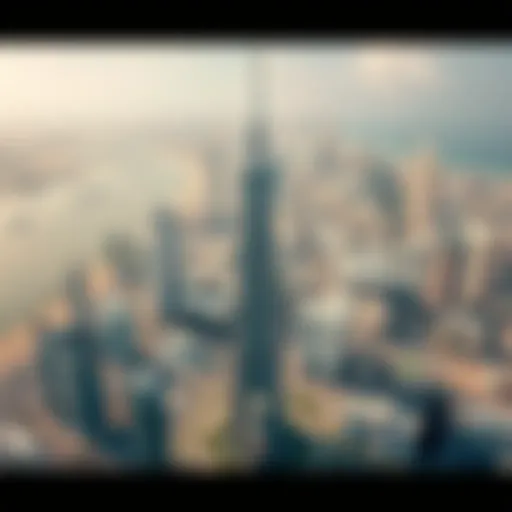Discovering Authentic Souvenirs in Dubai's Markets


Intro
Dubai, a shimmering gem in the Arabian desert, is renowned not only for its towering skyscrapers and extravagant lifestyle but also for its vibrant souvenir landscape. Every corner of this city speaks about its rich heritage and cultural tapestry through unique mementos that beckon locals and tourists alike. From intricately crafted artifacts to modern interpretations of traditional crafts, the souvenirs found here capture the essence of what Dubai represents – a harmonious blend of tradition and innovation.
Visitors often find themselves wandering through bustling markets and luxurious malls, searching for that perfect piece to take home. The quest for authentic souvenirs can be challenging, especially amid an array of mass-produced items that do little justice to the city's cultural identity. That‘s why understanding the underlying trends, locations, and craftsmanship becomes crucial in navigating this distinctive souvenir landscape.
In this article, we will delve into various facets of Dubai’s souvenir scene. We will explore market trends and insights, investigate categories of souvenirs that embody the local culture, highlight notable shopping venues, and provide advice on selecting genuine pieces. We aim to illuminate how these souvenirs not only serve as reminders of a journey but also as storytellers reflecting Dubai's evolution.
Let us embark on this journey to uncover what makes Dubai's souvenir market a melting pot of culture, creativity, and commerce, and delve deeper into the narratives that shape the identity of this remarkable city.
The Essence of Souvenirs in Dubai
When one thinks of Dubai, it’s easy to get lost in the shimmering skyscrapers and the bustling lifestyle. Yet, beneath this modern veneer lies a rich tapestry of stories waiting to be stitched together through souvenirs. The essence of souvenirs transcends mere objects; they encapsulate memories, cultures, and experiences.
Souvenirs are not just items you bring back from your travels; they are tokens of connection to a place. In Dubai, the variety is immense, reflecting the city’s blend of old-world charm and cutting-edge innovation. Whether it's a delicate piece of hand-carved wood from the souks or an intricately designed piece of jewelry, every item whispers tales of its origin. Here, souvenirs serve a dual purpose: they offer a sense of identity while also fostering a connection to the broader world.
Cultural Significance of Souvenirs
Acquiring a souvenir in Dubai goes beyond the act of purchase; it involves engaging with the local culture. These items act as bridges, linking travelers to the heritage of the United Arab Emirates. Each item often has a significance that tells a story about its maker, the methods used, and the traditions upheld. For investors and expatriates, understanding this cultural significance can afford valuable insights into the local market trends, potentially influencing their purchasing decisions.
"Souvenirs are not just a reminder of a place, but a tangible thread that weaves us into its narrative."
Benefits of Purchasing Souvenirs
When navigating through Dubai’s vibrant markets, the advantages of selecting authentic souvenirs become clear:
- Support Local Artisans: When you buy a souvenir, it often translates to economic support for local craftsmen and women, ensuring that traditional skills are preserved.
- Cultural Education: Each piece encapsulates the history and culture of the UAE, offering a mini-education on local traditions—perfect for realtors and architects looking to understand the region's architectural influences.
- Unique Connections: Souvenirs allow travelers to forge emotional ties with the destination. Whether it’s a spice blend from the Spice Souk or an ornate coffee pot, they relive their experiences every time they come across their unique finds.
Considerations for Souvenir Shopping
While the charm of souvenirs is undeniable, potential buyers must keep certain aspects in mind:
- Authenticity Matters: In a marketplace brimming with replicas and mass-produced goods, discerning authenticity is crucial. Look for items that reflect the craftsmanship and cultural heritage of Dubai.
- Practicality vs. Sentiment: It’s easy to be swept away by the hustle and bustle. Consider what you actually want versus what catches your eye. A thoughtful choice often brings a more profound sense of fulfillment.
- Legalities: Some items may have restrictions on export or ownership. Familiarizing yourself with local laws can save you from an unexpected hassle at customs.
In summary, souvenirs in Dubai are more than trinkets. They are powerful symbols of connection to a city steeped in rich traditions. By understanding their essence, buyers not only enrich their travel experience but also contribute to the sustainability of local cultures. For anyone involved in real estate or investment, recognizing the value embedded in these items can inform their perspectives and enhance their cultural appreciation.
As we delve deeper into the conversation about souvenirs, the cultural significance shines as a guiding principle that weaves through each category and market, deepening the understanding of what it truly means to engage with Dubai.
Cultural Significance of Souvenirs
When delving into the vibrant tapestry of Dubai, souvenirs often emerge as more than mere trinkets; they serve as tangible bridges connecting visitors to the rich cultural heritage of the region. Souvenirs embody a sense of place, preserving memories while simultaneously reflecting the traditions and innovations of the local community. For many travelers, these artifacts transcend mere physical objects, transforming into vessels of shared stories and experiences. They are markers of exploration, encapsulating unique narratives that establish deep connections with the locales visited.
Connecting with Local Heritage
In a city as dynamic as Dubai, where tradition intertwines seamlessly with modernity, souvenirs are crucial in grounding visitors in local heritage. Take, for instance, the intricate designs of Arabic calligraphy in pottery or textiles; these items carry with them centuries of history. By purchasing such goods, travelers not only take home a piece of artistry but also contribute to the preservation of age-old techniques that define Dubai’s cultural landscape.
Souvenirs like handcrafted jewelry or traditional perfumes embody the meticulosity and craftsmanship that local artisans uphold. This practice not only fosters a sense of pride among creators but also encourages tourism that respects and promotes local culture.
When picking up a carpet from a bustling market, one might unknowingly become a part of a narrative that spans generations, where each thread tells a tale of artistry passed from one generation to the next. Such purchases resonate with a deeper significance, a reminder that one’s journey is stitched into the very fabric of the artifact.
Souvenirs as Narratives of Travel
Souvenirs oftentimes serve as personal chronicles of travels taken. They encapsulate experiences, emotional connections, and shared moments with the local culture. A small bottle of Arabian spices or a scarf woven from silk can evoke memories of fragrant markets or festive celebrations one encountered along the way. Each item tells a chapter that can be revisited time and again, offering a lens through which to relive those precious adventures.
Moreover, these objects often trigger discussions around the dining table or within social gatherings, sparking curiosity about distant cultures. In this context, souvenirs act as storytellers; they offer a chance to share one’s journey with friends and family, transforming experiences into shared memories and shared understanding of the world.
By collecting souvenirs, travelers participate in the age-old tradition of storytelling, bridging gaps between cultures in a world where understanding and appreciation of diversity can foster connection.
"Souvenirs are not just reminders of places visited; they are the threads that weave together our experiences, crafting a global tapestry of shared stories."
Ultimately, understanding the cultural significance of souvenirs enhances the travel experience. When visitors choose to bring back authentic pieces of Dubai’s heritage, they are not just investing in a keepsake but also in a legacy that honors the lives and stories of those who crafted them.


Categories of Souvenirs
When one thinks of souvenirs, a vivid tapestry of memories and emotions springs to mind. The selection of these tokens goes far beyond mere trinkets; it's a window into the unique cultural fabric of Dubai. Each category of souvenirs tells its own story, providing travelers with layers of depth to appreciate beyond the surface. Understanding these categories not only enhances the experience but also fosters a genuine connection with the locale. This section will explore three main categories of souvenirs found in Dubai—traditional crafts, modern gadgets, and luxury collectibles—each serving its own vital purpose within the broader souvenir landscape.
Traditional Crafts and Artisanal Goods
In the heart of Dubai's bustling markets, traditional crafts present a snapshot of the city's heritage. Think of beautifully handwoven carpets, intricate pottery, and stunning pieces of jewelry made in the old ways. These artisanal goods echo the skills passed through generations, bringing with them stories and cultural significance.
Visitors can find items like Dabka-style embroidery on fabrics, often seen in local attire. Such craftsmanship isn’t just a nod to the past; it symbolizes the community's soul and history. The artisans who passionately create these pieces deserve a nod. They channel years of experience into every stitch and bead, ensuring that each product is not just for show but a tale wrapped in craftsmanship.
Additionally, procuring these items supports local economies and helps keep traditional art forms alive. Not only do buyers take home a slice of culture, but they also contribute to the livelihood of skilled artisans. This symbiotic relationship is what makes purchasing traditional crafts a deliberative choice, transcending mere consumerism.
Modern Souvenirs and Gadgets
While traditional crafts hold the charm of age-old customs, modern souvenirs cater to the fast-paced needs of today’s tourists. Think smartphone-related gadgets, miniature replicas of the iconic Burj Khalifa, or quirky t-shirts that capture Dubai’s spirit. These items often utilize contemporary trends while embedding local flair.
Such souvenirs are perfect for tech enthusiasts. For example, smart souvenirs—think of personalized keychains that can connect with devices or unique Dubai-themed phone cases. These products show how a city can blend its rich history with modern innovation. Here, the need for convenience meets a fashionable twist, appealing to a younger demographic as well.
Moreover, acquiring modern souvenirs often leads to interesting conversations and bursts of laughter back home. They're little tokens that spark stories, reflecting the diversity of global trends while still celebrating local uniqueness. It's the best of both worlds.
Luxury Items and Collectibles
For those with a taste for the finer things in life, Dubai presents an array of luxury items that are hard to resist. Picture designer handbags adorned with local motifs, stunning gold jewelry that gleams like the desert sun, or bespoke perfumes crafted from traditional Arabian scents.
Investing in these luxury souvenirs often feels like stepping into a world of exclusivity. High-end items are not just for show; they serve as symbols of status, capturing the opulence that Dubai is known for. Collectibles, such as limited-edition artworks by local artists or rare antique finds, add a layer of investment to these purchases.
But buying luxury doesn't only mean splurging. It can also be an opportunity to connect deeply with the brand's ethos. Many luxury items come with stories of their creation, making each piece unique and cherished far beyond its price tag.
This interplay between luxury and culture enriches the purchasing experience. It’s about the allure of craftsmanship and the prestige of owning a part of Dubai’s vibrant identity.
"In every corner of Dubai, souvenirs reflect a rich history and promise for the future; it's a dance between the old and the new."
By exploring these categories, one can identify their personal connection to Dubai’s memories and perhaps find that perfect piece that resonates with their journey. From traditional crafts that illustrate local heritage to modern gadgets that encapsulate current trends, and luxury collectibles that signify status, the rules of souvenir shopping in Dubai seem endless yet rewarding.
Key Markets for Souvenirs in Dubai
Dubai’s market landscape is a vibrant tapestry that interweaves tradition with modernity. In the context of souvenirs, these markets become essential not only for the variety of items they offer but also for the authentic experiences they deliver. Exploring these key markets provides travelers with an insight into the local culture while allowing them to take home pieces that hold meaning beyond mere material value.
Understanding where to purchase these souvenirs can enhance the shopping experience. It allows visitors to engage with the artisans directly, fostering a deeper connection with the craftsmanship involved. Here, we’ll delve into two primary categories of markets: the traditional souks and the contemporary malls.
The Souk Experience
The souk experience in Dubai cannot be understated. When you step into these historical marketplaces, the sensory overload is palpable. Each souk offers a distinct flavor, showcasing various merchandise while hinting at the rich storytelling behind them.
Gold Souk
The Gold Souk stands as a beacon of luxury and craftsmanship. This market boasts intricate designs and a vast selection of gold jewelry that is unmatched. One exciting aspect of the Gold Souk is its aura of negotiation; haggling is practically an art form here. Shoppers are often eager to forge a good deal, making the experience not just about purchasing but about interacting with local vendors.
The key characteristic of the Gold Souk is its sheer volume of gold displayed, sparkling under the vibrant lights. For many visitors, this represents more than just a shopping destination; it's about finding unique pieces that are imbued with cultural significance. One unique feature of the Gold Souk is its commitment to quality. The jewelry here is often 22 or 24 karat, providing an assurance of value that many other markets cannot. However, it also has its drawbacks; the market can be overwhelming for first-time visitors, and buyers must be cautious about quality verification.
Spice Souk
A trip to the Spice Souk is a must for those looking to take a sensory journey. The aromas wafting through the air from an array of spices can transport anyone to a different culinary world. This market offers a rich variety of spices, herbs, and blends, some of which are signature to traditional Emirati cuisine. It’s not just about buying spices—it’s about gathering the essence of local flavors and traditions.
The key characteristic of the Spice Souk is the colorful displays and the compelling stories associated with each herb and spice. Visitors gain insight into the cultural importance these items hold within local households. The unique feature of this market is that it provides not only spices but also dried fruits, nuts, and even traditional remedies. On the other hand, tourists might feel daunted by the myriad options, and ensuring authenticity may pose a challenge.
Textiles and Fabrics Souk
The Textiles and Fabrics Souk is a treasure trove for admirers of artistic textiles. Here, fabric isn’t merely material; it’s the foundation of culture. The colorful textiles, ranging from silk to cotton, narrate tales of the region’s heritage. Finding fabrics here means discovering the stories woven into them.
This souk’s key characteristic is its eclectic mix, with merchants often showcasing handmade materials that can be tailored into clothing or home decor. The unique feature of the Textile Souk lies in the opportunity for customization, with many vendors willing to create bespoke pieces for discerning buyers. However, the challenge could be navigating through the overwhelming options to discern quality amidst the colorful chaos.


Contemporary Shopping Malls
While the traditional souks echo the past, contemporary shopping malls usher visitors into the future of retail. These malls provide a different shopping avenue, blending global brands with the local flavor of Dubai.
The Dubai Mall
The Dubai Mall reigns supreme not just as a shopping center but as an architectural marvel. Hitting the ground running in this vast space, you’ll find an array of global brands alongside local designers, creating an enticing mix. One substantial benefit of the mall experience is its climate-controlled environment, offering a cool respite from the desert heat—something that makes it a popular choice for tourists.
The key characteristic of The Dubai Mall is its size and the additional attractions it houses, like an aquarium, ice rink, and even an indoor theme park. One unique feature is the iconic Burj Khalifa view; it serves as a stunning backdrop to the entire shopping experience. A downside could be the commercialized atmosphere; some visitors may feel the lack of authentic local culture amidst the internationally recognized stores.
Mall of the Emirates
The Mall of the Emirates shines with its distinctive offerings and attractions, most notably the indoor ski slope, Ski Dubai. Shoppers here can blend traditional shopping with modern virtual experiences. The key characteristic of this mall includes its diverse range of shops but also its entertainment options, making it a favored destination for families.
A unique feature of the Mall of the Emirates is the focus on both luxury and accessibility in its retail offerings. That said, the downside might be feeling overwhelmed by the multitude of options, from high-end brands to family-oriented entertainment.
In summary, whether wandering through the winding paths of a souk or browsing the polished floors of a mall, shopping for souvenirs in Dubai reveals layers of culture, history, and modernity. Each venue presents its own advantages and challenges, beckoning travelers to discover what lies behind each corner.
Selecting Authentic Souvenirs
Choosing the right souvenirs during your visit to Dubai is not just about picking up something pretty; it’s about connecting with the vibrant tapestry of Dubai's culture. Authentic souvenirs often serve as a snapshot of the local heritage, values, and artistry. Neglecting to select genuine pieces may lead to purchasing items that hold little sentimental or cultural value.
Recognizing Quality Craftsmanship
When it comes to finding authentic pieces, recognizing quality craftsmanship is paramount. Many artisans in Dubai have honed their skills over generations, and this dedication is often reflected in their work. Here are a few key indicators of quality:
- Material Assessment: Authentic items like handmade carpets or intricate jewelry should be made from high-quality materials. Natural fibers, real gemstones, or metals are often telltale signs of true craftsmanship.
- Examination of Details: Look for intricate designs and fine detailing. A well-crafted piece will exhibit careful attention to artistic details—think of the exquisite patterns found in traditional Arabian lanterns.
- Artisan Signatures: Genuine handmade products often carry the mark of the craftsman. This could be a name, a date, or even a symbol that reflects their origin.
In addition, engaging with the artisans themselves can provide valuable insights. Many local craftsmen and women are eager to share stories behind their creations, enhancing the overall experience of selecting your souvenir. It could be enlightening to learn about the methods behind handmade ceramics or the significance of motifs in textiles.
Avoiding Common Pitfalls
While wandering around the markets, it is easy to get sidetracked and make impulsive purchases. However, being aware of certain pitfalls can help ensure that you walk away with souvenirs that are truly representative of Dubai's culture. Here’s what to watch out for:
- Overpriced Goods: While bargaining is common in markets, be aware of prices. If something seems too costly, it likely doesn’t reflect its true value. Researching beforehand or asking locals for advice often helps.
- Mass-Produced Items: Steer clear of items that are clearly mass-produced. These might look appealing but often lack the charm and authenticity that come from handcrafted products. For example, a generic fridge magnet may be a quick buy, but it wouldn't hold the same emotional weight as a hand-carved wooden camel.
- Cultural Misappropriation: Be mindful of items that may disrespect local customs or traditions. Understanding the cultural significance behind certain pieces can help you choose items that resonate positively and ethically.
Remember that every souvenir holds a story. Choosing thoughtfully not only enriches your own experience but also contributes to the preservation of Dubai’s cultural legacy.
In summary, the act of selecting authentic souvenirs in Dubai transcends simple shopping. It’s a meaningful engagement with the city’s heritage and artistry. By recognizing quality craftsmanship and avoiding common pitfalls, you ensure that the treasures you take home with you tell a story worth sharing.
The Role of Tourism in Influencing Trends
Tourism plays a pivotal role in shaping the souvenir landscape of Dubai. As one of the world's leading travel destinations, the city attracts millions of visitors year-round, each with unique tastes, preferences, and expectations. These characteristics not only influence what kinds of souvenirs are in demand but also affect how local artisans and retailers adapt their offerings in response. Understanding this dynamic is essential for anyone looking to navigate Dubai’s vibrant market.
Evolving Souvenir Preferences
Dubai’s souvenir market isn’t stagnant; it’s constantly shifting to reflect both local and global trends. Visitors today want more than just a simple trinket to remember their trip. They seek experiences and connections that resonate on a personal level. Here are some ways preferences are transforming:
- Cultural Relevance: Tourists are increasingly inclined to purchase items that reflect the local culture, like handcrafted pottery or traditional textiles, over mass-produced merchandise.
- Sustainability: With growing awareness of environmental issues, many travelers prefer souvenirs that are eco-friendly or ethically sourced. This has led to a surge in demand for items made from sustainable materials.
- Personalization: Customizable souvenirs such as engraved jewelry or bespoke art pieces are gaining popularity. Visitors want their memories to be unique and tailored just for them.
These trends are not isolated; they represent a larger societal shift toward authenticity and mindfulness in consumerism, which is changing what tourists consider worth taking home.
Impact of Globalization
Globalization has undeniably influenced souvenir trends in Dubai. While the influx of international tourists brings diverse tastes and demands, it also introduces competitive pressures on local artisans. Here's how:
- Hybrid Souvenir Market: Tourists are exposed to a variety of cultural influences, resulting in a blending of styles. For example, one might see traditional Arabic designs on modern gadgets or apparel, catering to a broader audience.
- Access to Global Market: Local craftspeople now sell their products online, reaching customers from around the globe. This has expanded their market beyond local tourists, but it also means they must keep up with international standards of quality and design.
- Cultural Exchange: Tourists bringing global culture into Dubai influence local trends as well. New ideas and styles are integrated into local craftsmanship, creating a fascinating blend that reflects both local heritage and international influences.
In essence, tourism fuels the evolution of the souvenir market, challenging artisans to innovate while also preserving their heritage in a continuously globalizing world. Understanding these trends equips anyone interested in investing in Dubai’s market with the insights needed to make informed decisions.
The Evolution of Local Craftsmanship


In the heart of Dubai's vibrant landscape lies a rich tradition of craftsmanship that has evolved over the decades, merging age-old techniques with modern aesthetics. This evolution is not merely a byproduct of globalization or tourism; it reflects a piecing together of the old and the new, illustrating how local artisans adapt while still preserving their distinctive cultural identity. By understanding this evolution, one grasps the deeper narrative behind Dubai’s souvenirs, making them not just items of memory but carriers of history and tradition.
The importance of exploring this evolution cannot be overstated. The local craftsmanship serves as a bridge between generations, showcasing skills that have been honed over years, often passed down from parent to child. Additionally, this rich heritage enhances the experience of tourists and residents alike, providing them with not just a purchase, but a story, a slice of Dubai’s soul.
Traditional Techniques and Modern Innovations
Long before skyscrapers kissed the clouds, Dubai was well-known for its traditional crafts. The art of weaving, pottery, and metalwork thrived long ago, nurtured by the local environment and cultural exchanges along trade routes. Take for instance the intricate designs found in Arabic calligraphy or the beautifully woven dallah, the traditional Arabic coffee pot. These crafts not only served practical purposes but also spoke volumes about the artistic, cultural, and social nuances of the time.
Fast forward to today, and one can see how these traditional techniques are being reimagined. Many artisans are now experimenting with different materials and forms, influenced by contemporary design practices. For example, while a wooden handicraft might have once solely relied on local wood, modern variations now introduce materials like resin and acrylic, creating a balance between sustainability and aesthetic appeal.
Artisans today are better equipped to reach global markets. Online platforms provide them with a stage to showcase their work, attracting buyers who value authenticity and craftsmanship. Moreover, workshops and galleries blend the old with the new, creating spaces where patronage goes hand-in-hand with education, offering hands-on experiences to tourists and locals to appreciate the skill involved.
Supporting Local Artisans
Supporting local artisans is not just a monetary exchange; it’s about investing in the future of a cultural narrative. When tourists and residents choose to buy handmade goods, they are directly contributing to the sustainability of these age-old practices. It's a win-win scenario, where the artisans gain a livelihood, and buyers obtain unique, authentic pieces that carry the essence of Dubai.
Local initiatives and organizations strive to promote these artisans through fairs, markets, and exhibitions. They create networks that uplift voices often overshadowed by mass production. This sense of community is vital; as the proverb goes, "It takes a village to raise a child," and similarly, it takes a collective effort to ensure that local craftsmanship thrives amid rapidly changing market demands.
Moreover, as you dive into these markets, take a moment to engage with the artisans. Their stories, whether it be of the techniques they learned or the materials they gather, add immeasurable value to your shopping experience. By connecting with them, consumers participate in a cultural exchange that enriches everyone involved.
In a world increasingly characterized by fast fashion and mass product output, supporting local craftsmanship in Dubai stands as a testament to the city’s blend of modernity and tradition. Each piece bought not only tells the story of its maker but also transforms into a cherished memento that connects its owner to a culturally rich past.
"The true art of craftsmanship lives in the stories behind each piece, a reflection of the hands that shaped them."
In retrospect, the evolution of craftsmanship in Dubai signifies much more than a mere transformation. It encapsulates a journey through time, echoing the vitality of tradition while embracing the realities of modern innovation.
Souvenir Etiquette and Legal Considerations
The souvenirs that travelers bring back from Dubai serve as more than just mementos. They encapsulate stories, experiences, and often, the very essence of the culture from which they originate. However, appreciating these items extends beyond mere acquisition. Understanding souvenir etiquette and legal considerations is crucial for both tourists and locals involved in this vibrant market.
Cultural Sensitivity in Selection
When hunting for souvenirs, one must be mindful of the cultural narratives tied to each item. Souvenirs such as traditional clothing or artisanal crafts carry deeper meanings within the Arab culture. For instance, buying handcrafted items from local artisans reflects support for their craftsmanship and heritage. It’s advisable to engage with sellers to learn the stories behind their products as this respect can elevate the purchasing experience.
- Recognizing the symbolism behind particular patterns or colors can show respect.
- Be aware that some items might be sacred or considered inappropriate to replicate or own, as with religious artifacts.
To enhance your interaction, simply asking locals about the best places or items can reveal insights into what is appropriate to buy and how to engage with the culture respectfully.
Import Regulations for Travelers
Navigating through the legal landscape of bringing souvenirs back home requires a level of due diligence. International travel often comes with its share of regulations regarding what can be brought across borders. Educating oneself about these import regulations is paramount to avoid disappointment at customs.
"What might feel like a harmless trinket to one could be a legal headache for another on the other side of the border."
While some countries have very lenient rules, others may impose strict regulations against certain items. Here are some examples to consider:
- Endangered Species Items: Souvenirs made from materials like ivory or certain types of shells can lead to severe penalties as they are often illegal to import.
- Cultural Artifacts: Bringing items of historical significance without appropriate permits could lead to their confiscation.
A good rule of thumb is to keep receipts for all purchased items, as these documents can help clarify the legitimacy of the products. Additionally, checking specific regulations at customs.gov or your country's customs agency can provide clarity.
Epilogue: The Legacy of Dubai’s Souvenir Culture
In the grand scheme of tourism, souvenirs represent more than trinkets and mementos. Instead, they act as a mirror reflecting the cultural tapestry of a destination. In Dubai, this phenomenon is particularly pronounced. The journey to understand Dubai’s souvenir culture caters to not only the aesthetic desires of collectors but also the deeper need for connection and significance that travelers seek.
One cannot overlook the cultural context surrounding each piece. The intricate designs of an authentic Bedouin dagger, for example, do not just signify the craftsmanship embedded in UAE’s history but resonate with stories of nomadic tribes and their rich heritage. Each item tells a tale that transcends mere commercial interest, leveling up the emotional quotient of a simple purchase.
Moreover, as globalization continues to influence buying habits, it is crucial to recognize the balance between authentic local craftsmanship and mass-produced items flooding markets. One must weigh the value of a souvenir against the backdrop of sustainability and support for local artisans. Opting for handmade goods not only fosters local economies but also ensures that your purchase contributes positively toward preserving traditional arts and crafts.
"Souvenirs are not merely reminders of places you've been; they're connections to those experiences that linger long after the trip is over."
Considerations for Epilogue
- Cultural Significance: A souvenir from Dubai encapsulates history, artistry, and the cultural essence of a rapidly evolving city. Visitors often seek items that breathe life into their travel narratives, thereby preserving memories.
- Authenticity and Quality: Striving for genuine products invites tourists to engage with artisans, creating a more meaningful connection. They become stewards of the culture rather than mere consumers.
- Sustainability: Consumers should ponder the implications of their purchase. Supporting local craftsmen and women ensures that these art forms can be passed down through generations.
For those positioned at the crossroads of opportunity in Dubai—be it investors, realtors, or home buyers—the lush landscape of souvenirs offers insights into the pulse of the region. These items not only represent the allure of Dubai but are also tangible links to the economic and social fabric that sustains it. Understanding the legacy of souvenirs can not only enhance personal collections but also serve as a vital connection to the dynamic world of the UAE. By valuing these cultural emblems, all can partake in an ongoing dialogue about identity and heritage, enriching both the buyer and the broader community.
In summary, the legacy of Dubai’s souvenir culture is multifaceted. As cultural custodians, tourists and locals alike must ensure that the stories ingrained in these artifacts are not lost but instead celebrated and shared for years to come.















